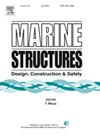随机森林集合下可操作海况的概率预测
IF 5.1
2区 工程技术
Q1 ENGINEERING, CIVIL
引用次数: 0
摘要
提出了一种概率海况分类方法(PSSC),利用预测的风、浪等海况参数来确定海况的可操作性。与类似的模型不同,所提出的方法从随机森林模型中产生一系列可能的结果,从而实现可操作性的概率评估,该评估考虑了模型的预测误差、预测不确定性和波浪荷载的随机变异性。通过一个案例研究对该模型进行了测试,该模型考虑了海底吸力锚部署过程中起重机钢丝绳的载荷,并将其与基于真实海况的基准决策和基于预测总波参数的常规决策进行了比较。与传统方法不同,PSSC模型在不同季节的波动特征下表现一致。应用极限状态(ULS)标准,在5年测试集中,负载超出的长期分布与目标10-1水平的基准分布密切匹配。然而,在概率评估中加入预测不确定性和建模误差改变了极端负荷的分布,使得基准在10-4的概率水平上被超过。实际应用需要更多的工作,建立修订的负载因子,或考虑使用蒙特卡罗模拟进行详细的可靠性分析。后者需要大量的训练,因为模型不能推断已知数据点之外的情况。本文章由计算机程序翻译,如有差异,请以英文原文为准。
Probabilistic prediction of operable sea states with a random forest ensemble
A Probabilistic Sea State Classification method (PSSC) is proposed to determine the operability of sea states from the forecasted wind and swell sea parameters. Unlike similar models, the proposed method produces an ensemble of possible outcomes from a random forest model, enabling a probabilistic assessment of operability that accounts for the model’s predictive error, the forecast uncertainty, and the random variability in the wave loads. The model was tested through a case study, considering crane wire loads during the subsea deployment of a suction anchor, comparing it against benchmark decisions based on the true sea state and conventional decisions based on the forecasted total wave parameters. Unlike conventional methods, the PSSC Model performed consistently across seasons with varying wave characteristics. Applied to an Ultimate Limit State (ULS) criterion, the long-term distribution of load exceedance over the five-year test set closely matched the benchmark distribution at the target 10–1 level. However, incorporating forecast uncertainty and modeling errors in the probabilistic assessment altered the distribution of the extreme loads, such that the benchmark was exceeded at the 10–4 probability level. More work is needed for practical application, establishing a revised load factor, or considering detailed reliability analyses using Monte Carlo simulations. The latter requires extensive training since the model cannot extrapolate beyond known data points.
求助全文
通过发布文献求助,成功后即可免费获取论文全文。
去求助
来源期刊

Marine Structures
工程技术-工程:海洋
CiteScore
8.70
自引率
7.70%
发文量
157
审稿时长
6.4 months
期刊介绍:
This journal aims to provide a medium for presentation and discussion of the latest developments in research, design, fabrication and in-service experience relating to marine structures, i.e., all structures of steel, concrete, light alloy or composite construction having an interface with the sea, including ships, fixed and mobile offshore platforms, submarine and submersibles, pipelines, subsea systems for shallow and deep ocean operations and coastal structures such as piers.
 求助内容:
求助内容: 应助结果提醒方式:
应助结果提醒方式:


